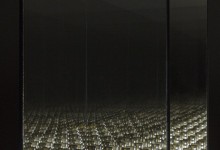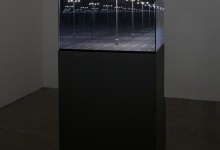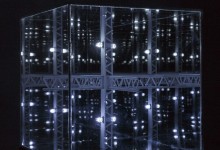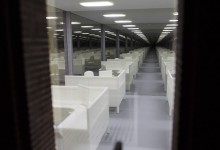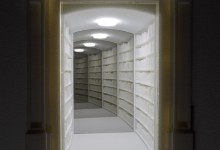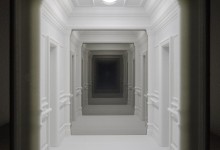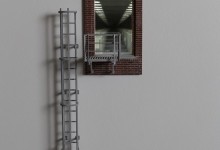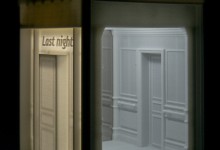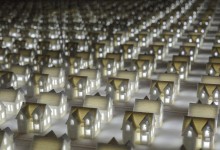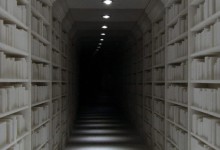Guillaume Lachapelle: Visions
The Architecture of Knowledge in the work of Guillaume Lachapelle
Text by L. Sasha Gora
Jorge Luis Borges imagined the universe as a library, one “composed of an indefinite and perhaps infinite number of hexagonal galleries.” 1The bookshelves in Guillaume Lachapelle’s rigorously detailed, architectural miniatures are similar imaginings of knowledge, infinity, and the meaning of books.
When Lachapelle predominantly sculpted with wood, the library was already present in his work. Take for instance the delicate shelves in Maneges (2004-2006). In 2009, he began to employ 3D printing and since, he has drafted bookshelves as white, intricately printed sculptures. Fissure, 2009, a bookshelf whose centre collapses, like quicksand, into a void; Le piège, 2009, an isolated balcony that protrudes from a bookshelf; Évasion 2, 2011, a fragile staircase that leads to a corridor library. Despite their sculptural form, these pieces never feel static. They suggest something beyond the shelves. Books are often described as gateways to other worlds and the artist Dominique Gonzalez-Foerster exemplifies this literally. In her 2013 La Bibliothèque clandestine at Palais de Tokyo what at first appears to be a bookshelf is actually a rotating door that opens into a secret gallery.
For Lachapelle’s sixth solo exhibition at Art Mûr, Visions, we encounter again the library. This time, he employs single-sided mirrors to exaggerate a sense of the infinite, getting closer to Borges’ indefinite library, such as in Awaiting Knowledge (2013). We confront the same architecture in Metro (2013) and Last Night (2013). A library, a subway car and a hallway from the Titanic, respectively, all melt into an intriguing yet alarmingly dark void. Where does the darkness at the end of hall lead to? Lachapelle’s miniatures act as a threshold between what is seen and not seen.
Although a good five centuries apart, the printing press and 3D printing both belong to the history of print. However, in Lachapelle’s miniatures, books are separated from their use. We cannot read them. They are rendered decorative, almost fetishized, and so instead we must mediate on their symbolism. This requires imagination. Lachapelle’s models are far too tiny for us to occupy physically, and so we must occupy them with our imagination, as when we occupy books, turning the words into the stories and images of people and places.
In Borges’ story, what began as extravagant happiness – the Library of Babel housing all books and holding all of the world’s answers – turned to depression: “The certitude that some shelf in some hexagon held precious books and that these precious books were inaccessible, seemed almost intolerable.”2 For Lachapelle, books represent a similar anxiety: as much as we know, there is always more that we don’t.
1. Jorge Luis Borges, Labyrinths, ed. Donald A. Yates and James E. Irby (London: Penguin Classics, 2000), 78.
2. Ibid, 83.


